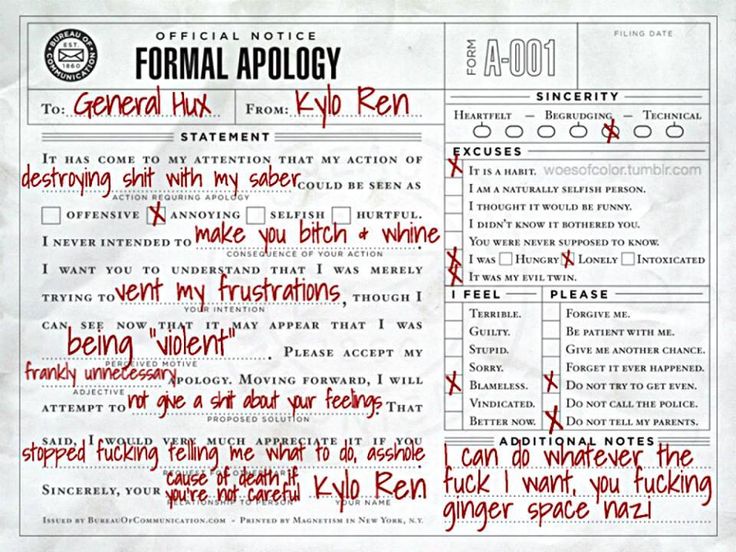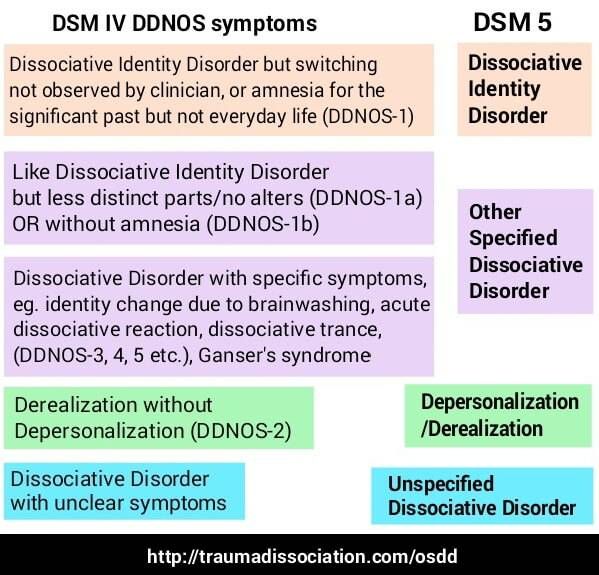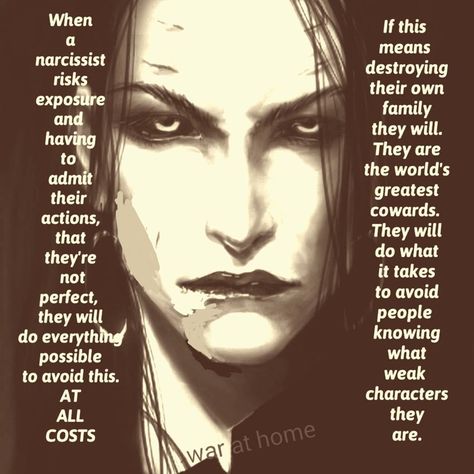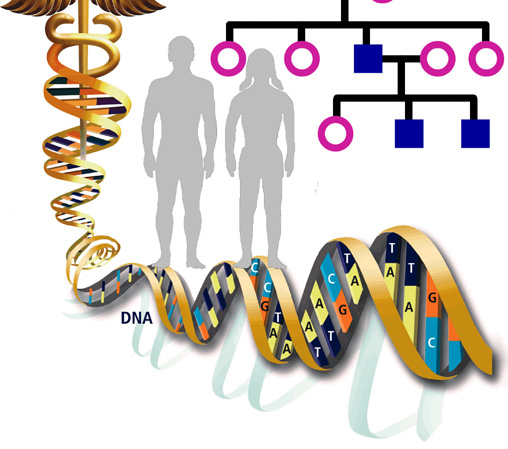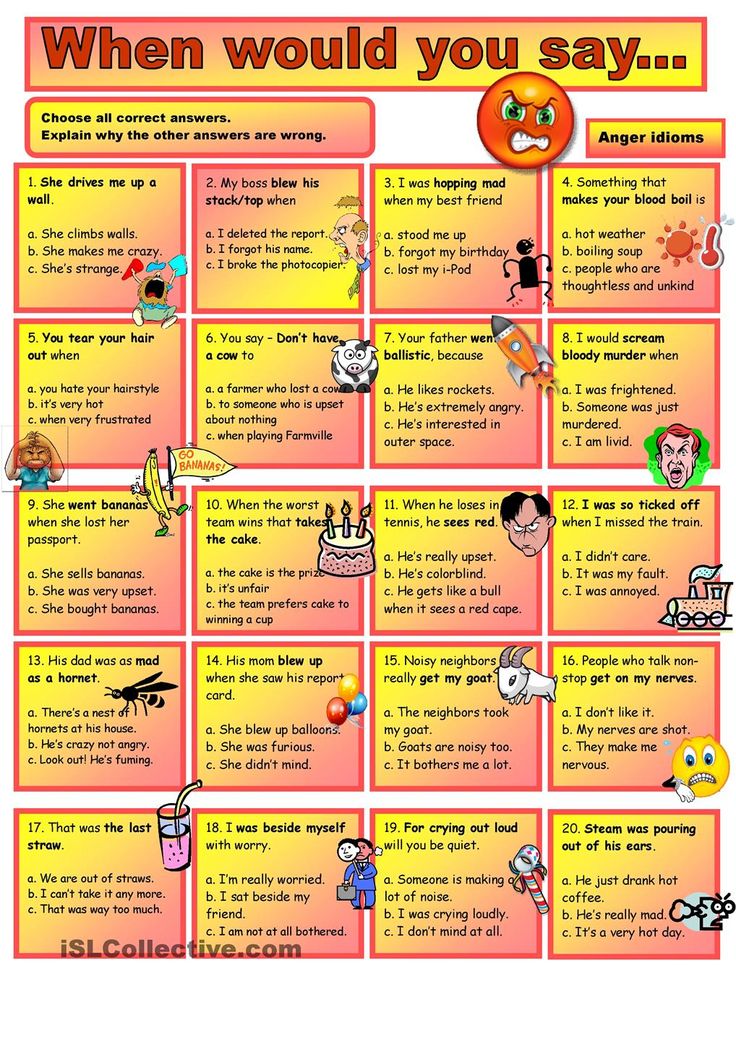A sincere apology
The 7 Steps of a Sincere Apology
You are here: Home / Daily Life & Must-Knows / Etiquette Essentials / How to Apologize: The 7 Steps Of a Sincere Apology
Author Shared by Maralee McKee on
How to apologize can be the key to getting true forgiveness and moving a relationship forward in a positive way. Let’s look at seven tips for apologizing sincerely and successfully!
By: Maralee McKee
In the middle of an intense moment, we all occasionally say or do something that, depending upon our mood, hurts others either intentionally or accidentally.
Then, when we come to our senses, we realize an apology is in order for the pain we caused.
And not just any old apology.
FREE Five-Day Challenge
LEARN THE 25 HABITS OF A REMARKABLY CLASSY PERSON.
Count Me In!Since we’re sorry, we want to offer an apology that will let the person we hurt know how much we regret our words or actions — an apology that moves us past the situation into greener pastures where the offended person trusts us, our motives, and our words again.
In short, we want to offer an apology that’s sincere and restorative.
But How?
People who are hurt tend to think irrationally, and that’s due to anger. In the same way that anger clouded our discernment when we said or did the thing that got us into this situation, anger can cloud angry people’s ability to forgive.
While we know we should apologize, it’s not always easy. Doing so opens us up to the possibility of being confronted with anger and resentment by the offended person(s).
And it’s not always easy for them to accept our apology. They can wonder whether it’s the truth — perhaps the words we’re apologizing for are still our true feelings.
The secret ingredient to sincerely offering or accepting an apology is intention.
When we apologize to people from our heart — and mean it — we hope they’ll decide with their mind to accept our mea culpa.
Not because it’s easy to forgive and forget, not because we necessarily deserve it, but because they’ve intentionally decided to forgive us.
Besides, not forgiving us hurts them more than it hurts us. After we apologize, our life looks and feels pretty much the same, but for the person who doesn’t forgive, the sun shines dimly on their days. That’s because they see things through the dark lenses of bitterness, anger, and unforgivingness.
And for those of us who need to offer an apology, let’s not wimp out or let pride get in the way. Let’s intentionally try to right our wrong. Doing so not only speaks to our character, but it’s proof of our character.
Be kind and compassionate to one another, forgiving each other, just as in Christ God forgave you. ~Ephesians 4:32
So what do we say and do to offer a sincere apology intentionally? Here are the seven steps of how to apologize sincerely.
How to Apologize —The 7 Steps of a Sincere Apology
1. Ask for permission to apologize.
Those whom you’ve offended appreciate that you’re not jumping right in and assuming you can do something that involves them. Sometimes, the permission to apologize comes right away, and sometimes it comes after those offended have had a chance to cool off. When they grant you permission (and they will, because they very much want to hear what you have to say), let them know in detail what you’re apologizing for. Those offended need to hear from you what you did so they know you understand why they’re upset.
Sometimes, the permission to apologize comes right away, and sometimes it comes after those offended have had a chance to cool off. When they grant you permission (and they will, because they very much want to hear what you have to say), let them know in detail what you’re apologizing for. Those offended need to hear from you what you did so they know you understand why they’re upset.
2. Let them know that you realize you hurt them.
Tell them how much you regret what you did, you know it was wrong, and you value their feelings. Express that you wish you could turn back time and change what you said or did.
Be careful not to say anything along the lines of “If I hurt you, I’m sorry.” Doing so means that you don’t understand that you did hurt the person. “If” and words like it put the blame on the other person for feeling hurt instead of on the person who committed the offense.
3. Tell them how you plan to right the situation.
Sometimes, it’s not possible to right a situation.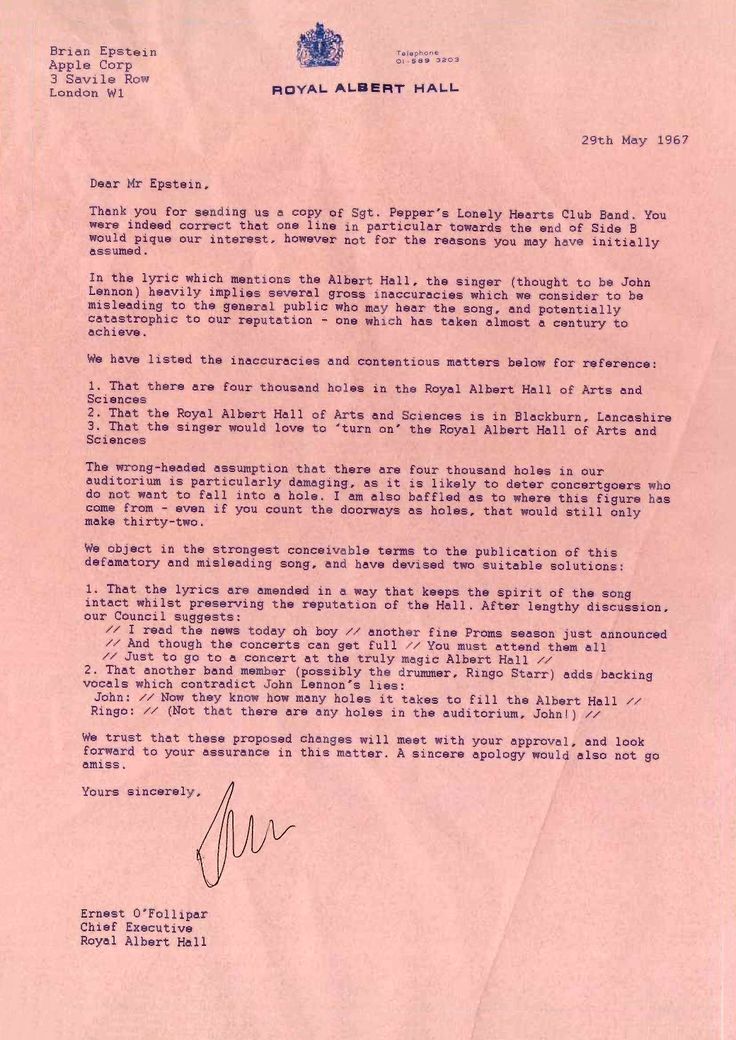 When it is possible, do everything you can to make it right. When it’s not, let the person(s) offended choose the outcome they’d like to see.
When it is possible, do everything you can to make it right. When it’s not, let the person(s) offended choose the outcome they’d like to see.
4. Let them know that inherent in your apology is a promise that you won’t do what you did again.
Step 4 is crucial. Otherwise, what you’ve offered isn’t an apology — it’s an excuse.
5. After you’ve talked through things, formally ask them for forgiveness.
“Laura, I’m asking for your forgiveness. Will you please forgive me?” If what you’re asking forgiveness for is something that caused a deep hurt, add, “I understand you need time to think about it.” What you don’t want to do is to assume that just because you asked for their forgiveness, they’re going to hand it right over to you.
6. Consider following up with a handwritten note.
Why? The note is a permanent reminder of your remorse and your promise not to repeat the offense. It also helps you keep your promise because — well, they have it in your handwriting that you will. Think of it as a forgiveness promissory note.
Think of it as a forgiveness promissory note.
7. Now it’s time for both people to go forth and live out their promises.
If Laura accepted your apology, that means she can’t hold a grudge and bring up what you did every time she gets angry with you. And you (who apologized) can’t go around doing what offended her in the first place.
A sincere apology should be given and accepted with the intention of restoring the relationship.
Sometimes, it takes time for things to get back to the way they were, but they can be even better than the way they were. Intention can move relationships to a deeper level of respect, harmony, and care for one another. When deciding how to apologize, just remember to keep front and center the words of Benjamin Franklin: “Never ruin an apology with an excuse.”
Until next time, keep giving the world what only you can give: you at your authentic best!
XOXO,
apologize apologise apologising (common alternate spellings)
Filed Under:
Children & Family Common Situations Etiquette Essentials Personal Polish Skills of Gracious Ladies Teach By Example What to Say WhenAbout Maralee McKee
Maralee McKee is dedicated to helping you become the person you most want to be and to live a confident, kind, and generous life! She is a contemporary etiquette, manners, and people skill expert and the founder of the prestigious Etiquette School of America. She's in the top one percent of experts in her field, and her etiquette skills blog is the most read in the United States. Maralee presents business etiquette seminars to corporations large and small and coaches individuals one-on-one virtually and in-person. Her book on how moms can teach their children to become the best version of themselves (Harvest House Publishing) earned the prestigious Mom’s Choice Gold Award for excellence in parenting books.
She's in the top one percent of experts in her field, and her etiquette skills blog is the most read in the United States. Maralee presents business etiquette seminars to corporations large and small and coaches individuals one-on-one virtually and in-person. Her book on how moms can teach their children to become the best version of themselves (Harvest House Publishing) earned the prestigious Mom’s Choice Gold Award for excellence in parenting books.
Join the Most-Read Etiquette, Soft Skills, and Interpersonal Communications Blog in the United States!
FREE Five-Day Challenge
LEARN THE 25 HABITS OF A REMARKABLY CLASSY PERSON.
Count Me In!5 Steps to a Sincere Apology
As much as I strive to be kind, there are days when I fail miserably. I’ll wake up in a bad mood, the kids will be cranky, and a million little things won’t go my way. My hormones will be unstable, the budget won’t balance, and I’ll get some terrible news. Life will weigh me down – it happens to all of us.
Life will weigh me down – it happens to all of us.
When I’m feeling less than pleasant, I am more likely to make mistakes. I lose my patience. I say things that are unkind. It’s often unintentional, but nonetheless, I hurt others.
Whether it’s my friend, my colleague, my spouse, my children, or even a stranger – no one deserves to be treated unkindly because I am having a bad day. So it’s been important for me to learn a lesson in retroactive kindness – to learn how to truly apologize.
It’s never an easy thing to do. Admitting you were wrong and owning up to your bad actions is a humbling experience. A true apology leaves you vulnerable and exposed and oh so uncomfortable. But it also leaves you with a better understanding of yourself and others, and hopefully will give you the empathy to avoid the same hurtful path in the future.
Here are my 5 uncomfortable steps to a sincere apology, from someone who’s had to eat their fair share of humble pie:
1. Name what you did wrong.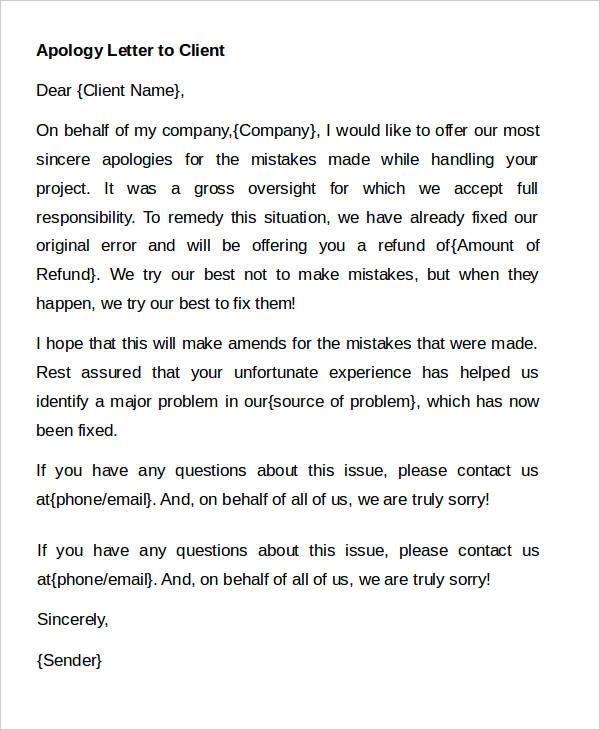 Don’t just say: “I’m sorry you got hurt.” That’s not owning up to your actions. Instead say: “I’m sorry I called you naïve” or “I’m sorry I shoved past you.” Be specific about your actions and why you are apologizing for your behavior.
Don’t just say: “I’m sorry you got hurt.” That’s not owning up to your actions. Instead say: “I’m sorry I called you naïve” or “I’m sorry I shoved past you.” Be specific about your actions and why you are apologizing for your behavior.
Even more importantly, don’t project your actions as someone else’s fault. “I’m sorry you made me act that way” is not an apology at all. No one can make you react a certain way. You are the one responsible for your actions and words.
2. Use empathy. Maybe your actions wouldn’t have hurt you, but the fact is that they hurt someone else. Acknowledge their feelings as legitimate. Try to see things their way, and let them know you understand their hurt. For example: “I’m sorry I showed up for dinner so late. I know it made you feel unimportant, and I should have respected your time more.”
Usually people get hurt because you are putting yourself first, so make sure you put yourself in their shoes when you’re apologizing.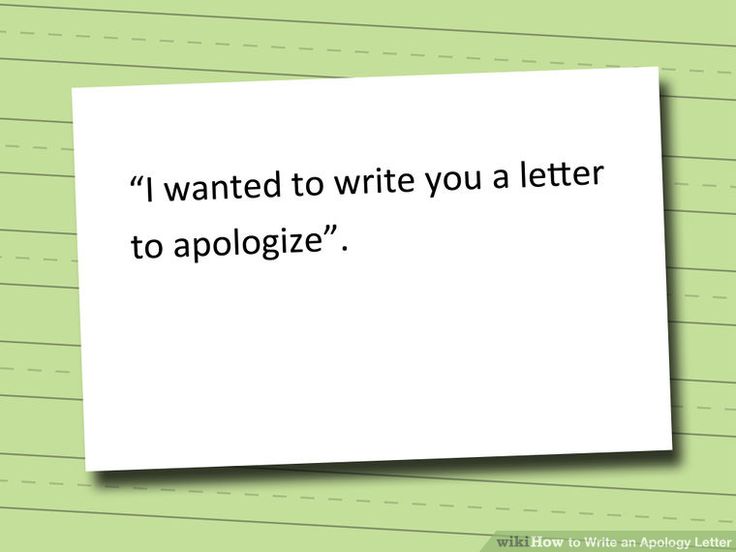
3. Make it all about you. If a fight has erupted, and you’re the first to come forward and admit you were wrong, keep the apology all about you. Don’t focus on what the other person did wrong or how they provoked your actions. Pointing out the other person’s faults and demanding a reciprocal apology will undermine everything else you say. If you’re only saying sorry so they will say sorry too, you need to rethink your reasons for apologizing in the first place.
4. Keep explanations brief. You should definitely think about the root reason that you were unkind before you apologize. Like I said before, no one can make you react a certain way, so whatever the other person did is irrelevant. Maybe you were feeling insecure about yourself or maybe you were under a lot of stress at work or maybe you were feeling a bit jealous.
You can explain yourself if the reason is relevant, but keep it brief and remember that it doesn’t justify your behavior – and say so. “I was stressed out about my project deadline, but that doesn’t make it okay for me to yell at you. I’m so sorry I acted that way.”
“I was stressed out about my project deadline, but that doesn’t make it okay for me to yell at you. I’m so sorry I acted that way.”
5. Let it go. Once you’ve apologized, it’s time to take a cue from Frozen and let it go. What happens next isn’t up to you. As hard as it may be to put yourself out there and truly apologize, the fact is no one owes you their forgiveness. It’s not something that can be earned. Forgiveness is a gift, and quite frankly, one you never deserve.
Don’t try to force someone to accept your apology. If the other person doesn’t want to repair the relationship, respect their decision. Let go of any resentment and anger, and once again, try to see things their way. You can only do so much before it’s time to let it go.
What distinguishes sincere apologies from fake
Man and woman
As a psychotherapist, I often hear apologies or regrets from clients. Sometimes they say them simply because they want to change the subject, when they are not really remorseful. Or they say this to calm their spouse or spouse if they came together, or when they feel a personal defeat. All these apologies are useless, because they are insincere, they do not help to improve relations.
Or they say this to calm their spouse or spouse if they came together, or when they feel a personal defeat. All these apologies are useless, because they are insincere, they do not help to improve relations.
Only true repentance helps to get closer. They show that you really care about your partner, their thoughts and feelings. Unsuccessful apologies, on the contrary, spoil the relationship more. Let's give some examples. nine0003
1. “Sorry, sorry, sorry.” These passive-aggressive "apologies" are said simply to change the subject and silence the partner. They show that you do not take his experiences seriously.
2. "I'm sorry it happened, but...". "But" is a clause that changes everything. If you can't apologize without a "but," then you're not sorry. This is just an attempt to justify.
3. "I'm sorry for ... but not for...". The first is usually some small thing, and the second is a major offense. So you try to avoid responsibility and passive-aggressively transfer the blame to your partner. nine0003
nine0003
4. "I'm sorry, but you yourself...". This is how you put all the blame on your partner. Such an apology is not sincere.
5. "I'm sorry it happened." An overly generalized apology without any specifics shows that you are not really ready to take responsibility for your actions.
6. "Sorry" (with laughter). Laughter sounds like a mockery of the interlocutor and his feelings about what happened, as if you are trying to belittle him. nine0003
7. "Sorry" (with tears). Excessively emotional regrets with tears are also not sincere. You put on a show and turn attention to yourself, forgetting about those who suffered from your actions.
8. "I'm sorry I hurt you." In the right situation, this expresses sympathy. But often such a phrase seems to hint to the partner that he is too vulnerable and sensitive.
9. "Sorry for the interruption." You are afraid of conflict or want to hear "Yes, you don't bother me. " This shows your deep insecurity and disrespect for the interlocutor. nine0003
" This shows your deep insecurity and disrespect for the interlocutor. nine0003
10. "Sorry, but I don't agree." Again, usually in this way you are trying to soften the subsequent aggressive attack towards the partner.
11. "Well, I'm sorry." To do this in an exaggerated and sarcastic manner is a mockery of the partner's feelings.
12. "I'm sorry" (for no reason). It devalues the moments when repentance is really needed. Usually this is done out of shame or trying to get rid of unpleasant emotions.
13. "I plead guilty when you do this." This is an attempt to turn an apology into a contest in which there must be a "winner" who is ready to admit guilt only after the partner does.
14. "I will only apologize once." This is an attempt to control your partner, you demand to forgive you here and now, regardless of his feelings.
15. Refusing to ask for forgiveness. If you refuse to do this when necessary, you show pride and an inability to repent. nine0003
If you refuse to do this when necessary, you show pride and an inability to repent. nine0003
16. Too frequent confessions. Yes, sometimes one "I'm sorry!" not enough to show remorse, but too frequent are no longer taken seriously.
17. Trying to make amends with gifts. Some people are not ready to discuss misdeeds, preferring instead to give expensive gifts. At the same time, they do not accept responsibility for what happened and are not ready to change.
18. Attempts to distract from feelings of guilt. Sometimes we are so tormented by this feeling that we start doing useless things to distract ourselves. The problem is that it doesn't help repair the relationship. nine0003
True repentance can change the dynamics of a relationship, heal wounds, strengthen intimacy, love, and mutual support.
1. Apologize for specific things. List why you are doing this, without reservations. Sometimes it's better to write it down on paper.
Sometimes it's better to write it down on paper.
2. Use correct intonation. You need to find the right balance, not falling into hysterics with sobs, but not remaining indifferent. Show that you sympathize with your partner and regret the pain they have caused. nine0003
3. After you've done this, really change your behavior. Repentance is not just a momentary impulse, it leads to long-term changes that will require time and patience.
4. Don't just throw around excuses. It is worth doing only when you are guilty, then your words will be taken seriously.
5. Make up after an apology. It is not enough to ask for forgiveness, you need to reconcile on terms that suit both. nine0003
If both partners abide by these rules and avoid false apologies, the relationship is good. It is always joyful to see repentance, the desire to fix everything and live in love and harmony.
About the author
Christine Hammond is a psychologist. Her website.
Her website.
Source: pro.psychcentral.com
Text: Nikolai Protsenko Photo Source: Getty Images
New on the site
0003
In honor of the ex, grandfather and elephant: the Russians told how their parents chose their names
Women can be abusers of men, but they are not condemned: the opinion of a reader and a psychologist
What is wrong with Prince Harry and his book “Spare” — psychologist's opinion
“I found out that a man has another woman in parallel with me, but he does not confess…”
Coaching or quackery: how to distinguish a specialist who can help from a person who is trying to cash in on you
“What does the dream mean: my father is pestering me? It didn’t happen in real life”
Black-and-white thinking, catastrophizing, mental filter: 6 typical thinking traps — test yourself
psychotherapist’s advice • Articles on the website of the BOMBORA publishing house
“After a mistake, many of us automatically say “forgive me”.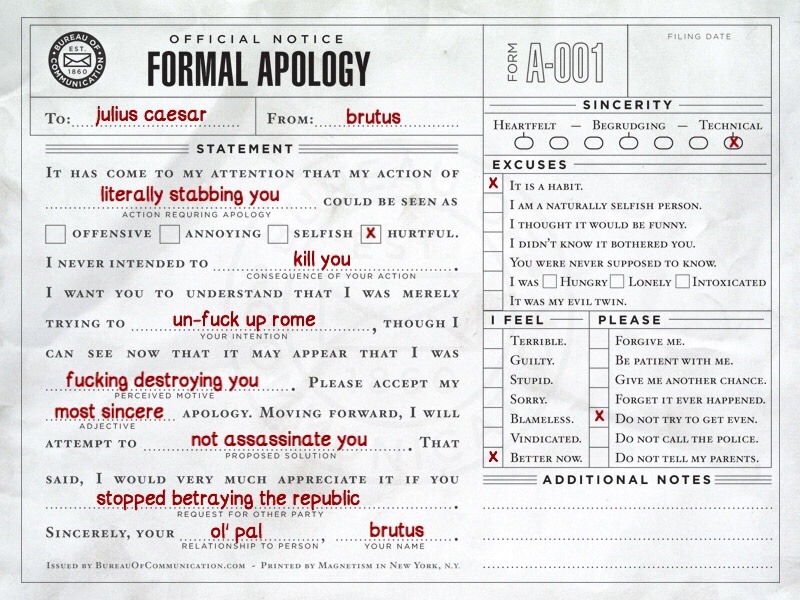 But even if these words were uttered in a sincere attempt to build a relationship, they are often not enough, ”says psychotherapist Molly Howes. Over thirty years of work, Howes developed her own methodology for a quality apology and shared it in the book No Offenses. We share four Howes steps that will teach you how to apologize so that you always forgive. nine0003
But even if these words were uttered in a sincere attempt to build a relationship, they are often not enough, ”says psychotherapist Molly Howes. Over thirty years of work, Howes developed her own methodology for a quality apology and shared it in the book No Offenses. We share four Howes steps that will teach you how to apologize so that you always forgive. nine0003
Step 1. Do nothing, just be there
The first step is to listen carefully and understand the other person's feelings. If you ask for forgiveness without understanding the cause of the offense, you can apologize for something other than what we are really to blame for. Since we often do not know the experience of other people and do not see our own mistakes, these same people should point them out to us. It's like driving: we can't get rid of the blind spot, but as responsible drivers we have to keep it in mind at all times. nine0003
We do not need to change our minds about ourselves in order to listen to someone else's vision of our actions. You don't even need to believe that we really did harm. But you need to fully focus on the other person while discussing how you influenced him. Hear about his pain.
You don't even need to believe that we really did harm. But you need to fully focus on the other person while discussing how you influenced him. Hear about his pain.
Often apologetics interrupt this step with defensive maneuvers, trying to justify themselves or devalue the other's complaint. It is difficult to remain silent when someone describes our actions in such a way that they seem unfair or inaccurate. However, at this stage we must not counterattack. Only listen. nine0003
Phrases to help:
“I thought I knew what happened, but I must have missed something. Explain me please?"
"I offended you greatly, and I sincerely want to understand what my fault is."
"I want to understand and will do my best to just listen."
The next steps will also require patience, humility and courage. But when we take the first step, we create momentum. Healing has already begun.
Step 2. Be sincere
In the second step, we must show that we understand how the other person suffered, that we care about it. This is the time to show that we take responsibility for the harm done to others. Even if it wasn't intentional. It is important to remember that it is the other person, not us. The essence of the second step is empathy for the victim, not atonement for sins, and the apology should focus only on the feelings of the interlocutor.
This is the time to show that we take responsibility for the harm done to others. Even if it wasn't intentional. It is important to remember that it is the other person, not us. The essence of the second step is empathy for the victim, not atonement for sins, and the apology should focus only on the feelings of the interlocutor.
Phrases to help:
“I'm sorry that I drank too much / argued / arrived late / neglected a serious occasion and ruined such an important day for you. I have no excuse." nine0003
“It's my fault that I didn't foresee everything. I'm really sorry".
“I should have realized how much this means to you. I'm so sorry you had to go through this alone."
One must speak sincerely and to the point. Ornate statements distract from the most important thought: we are aware of responsibility and regret. If we have been able to express sympathy and sincere regret, we are already halfway to forgiveness.
Step 3.
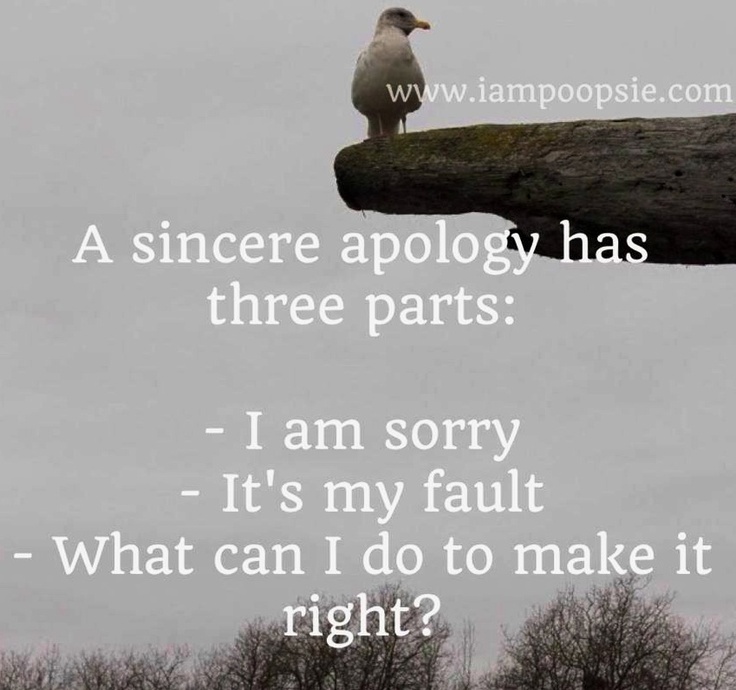 Make amends
Make amends The main question for the third step is: what can compensate for pain or injustice? What compensation can restore the disturbed balance? nine0003
In personal relationships, "compensations" are usually not material. It may seem that compensation is not applicable here, but it is not. For example, if someone is wrongly accused, a true story can be made public as compensation, and this will correct the misunderstanding. Another example: if we forgot about the anniversary, it's time to organize a new holiday.
The main thing is to make sure that the compensation is equivalent to the pain caused and generally acceptable to the person. That is, you need to “compensate” in the language of your opponent. nine0003
Phrases to help:
“I want to help you calm down. I have a couple of ideas. Maybe discuss them?
"What can I do to ease the pain my mistake has brought you?"
"What can help you trust me again?"
Go to the last step.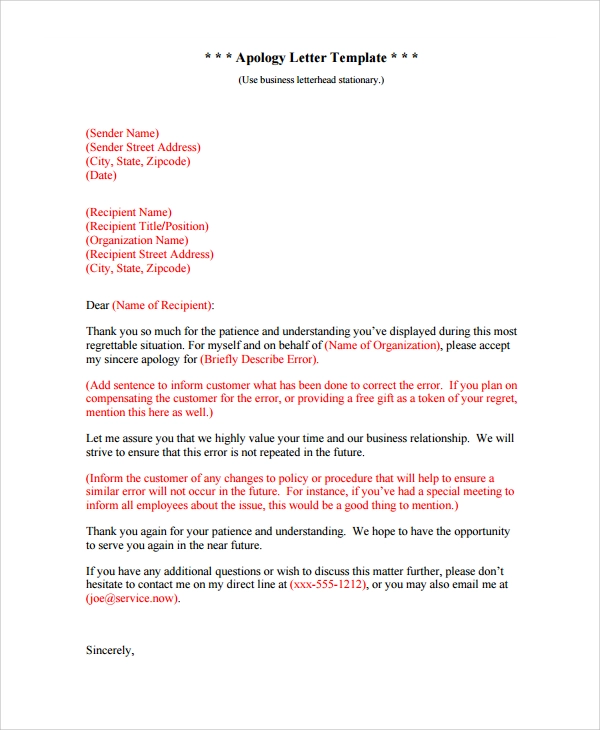
Step 4: Never Again
Just because we apologized and made amends, you can't be sure it won't happen again. The offended side is often wary of repetition. Can people really move on if this same situation can ruin everything again? Is it true that all grievances are forgotten if the causes of pain still exist? Step four is the one most often overlooked by apologetics. But it is in it that all the important results are hidden. nine0003
Its essence is to accept obligations that will not allow you to step on the same rake. In practice, this means: better understand the roots of your defensive reactions and their triggers, identify self-destructive or harmful behavior, change habits. This often requires some form of soul searching or greater self-awareness, sometimes the help of a psychologist.
Phrases to help:
"Here's what I'll do to make sure this never happens again."
"I want to do my best to earn your trust again" nine0003
"Please tell me if you see us slipping back into the old style of communication.